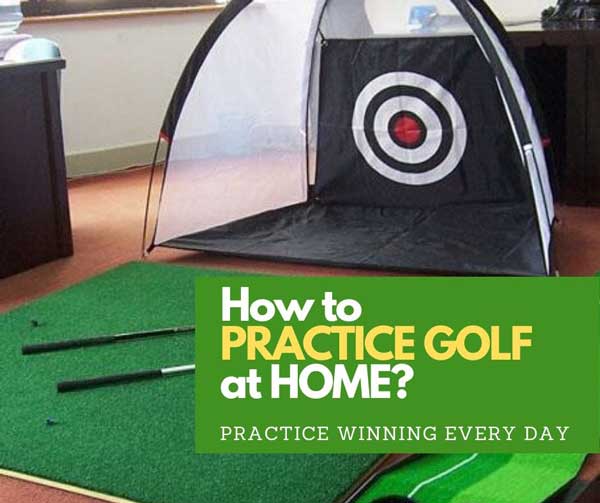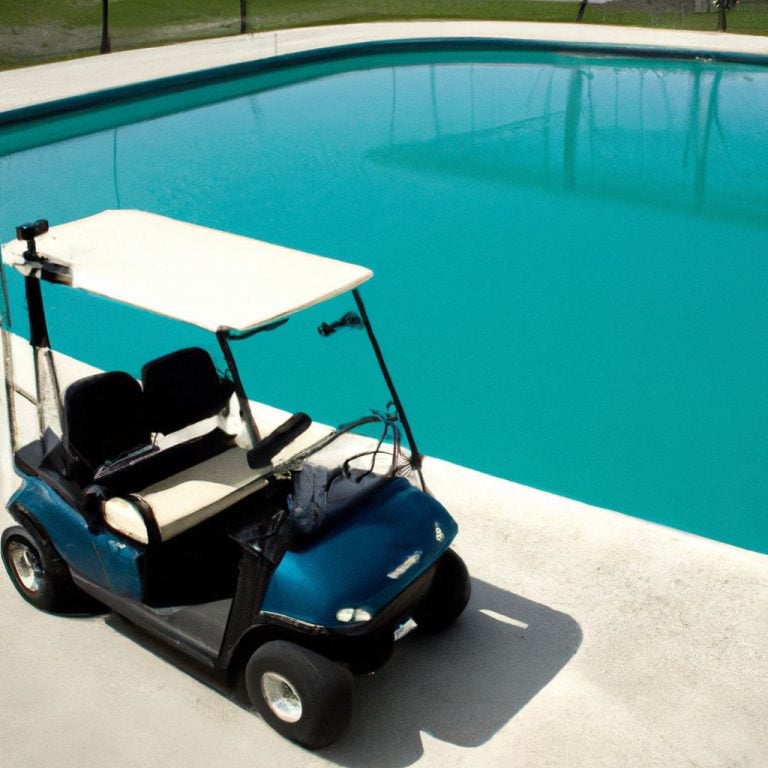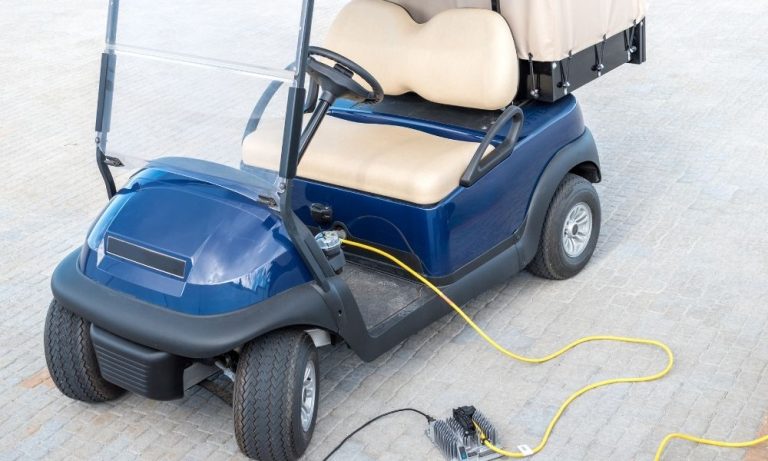H to practice golf at home
Key Takeaway:
- Practicing golf at home is becoming increasingly popular, offering convenience and accessibility to players without the need for a golf course.
- For putting practice, it’s important to focus on alignment, swing path, and stroke consistency. Using putting aids and setting up targets can provide feedback and help improve these skills.
- To improve chipping, utilize a small carpeted room and practice various drills to develop strike, accuracy, and distance control.
- Golf swing drills can enhance technique, impact position, and overall fundamentals. Utilize a mirror or window for feedback and vary speeds to further improve.
- Optional extras in home golf practice include incorporating golf fitness exercises like yoga, stretching, and core strength training, as well as utilizing mental practice techniques and visualization.
- When practicing golf at home, budget-friendly options are available for both the long game and short game setups, depending on individual budgets and requirements.
- Quality hitting mats and nets are crucial for safety and accuracy while practicing golf at home.
- Exploring the world of golf simulators, like the PhiGolf WGT Edition Simulator, can provide a virtual practice experience.
- A comprehensive guide to home practice should cover putting, full shots, and wedge play, focusing on stroke quality, impact tendencies, swing tempo, low point control, distance control, trajectory, and turf interaction.
- Conclusion: Encourage experimentation and engagement in home golf practice to continuously improve skills and enhance the overall golfing experience.
Introduction: The Increasing Popularity of Practicing Golf at Home
The increasing popularity of practicing golf at home has provided golfers with unique opportunities to refine their skills. In this section, we will explore the art of putting practice and how it can improve alignment, swing path, and stroke consistency. Discover effective techniques that can be incorporated into your home practice routine, as we delve into the world of honing your putting skills without stepping foot on the course.
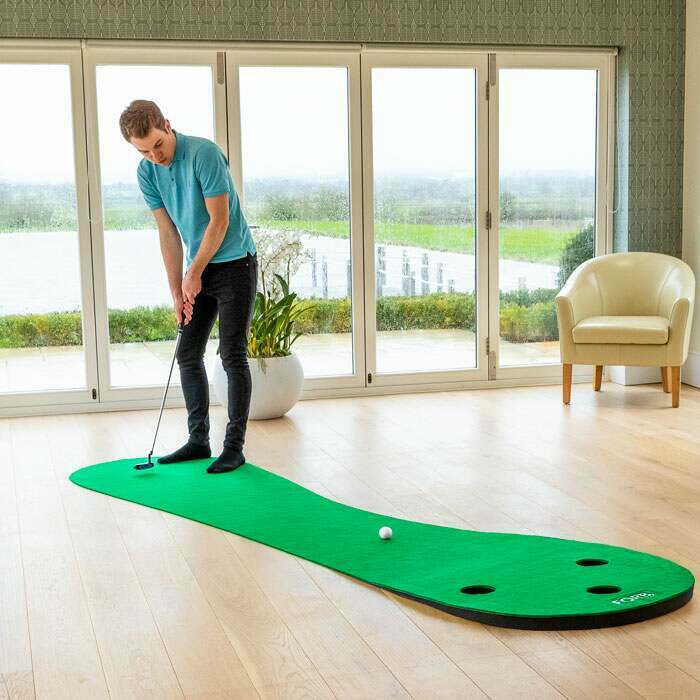
Putting Practice: Improving Alignment, Swing Path, and Stroke Consistency
Practicing putting is essential for golfers aiming to upgrade their alignment, swing path, and stroke consistency on the green. Dedicating time to this part of the game can help golfers to up their performance and have an edge over their competition.
- Set a target and use aids for feedback.
- Creating a target area helps golfers concentrate on their alignment and accuracy.
- Alignment sticks or mirrors give immediate feedback on stroke mechanics.
- These aids help develop a steady swing path and guarantee reliability in the contact between the putter and the ball.
- Different putting arcs based on style.
- Golfers have distinct putting styles that affect their preferred putting arc.
- The straight-back-straight-through arc is suitable for golfers with an upright stance and minimal body rotation during the putt.
- An arched putting arc works well for those with more body rotation and an open stance during the stroke.
Apart from these points, other aspects of putting practice need to be considered for improvement.
Tools and activities that refine stroke quality can sharpen a golfer’s capacity to manage speed, distance, and precision. Drills that challenge players with different slopes, distances, or obstacles help imitate real-life green conditions.
Advice for successful putting practice includes putting strokes with various speeds to create delicate touch around the hole and longer-distance control. Also, striking the ball regularly in the center of the putter face encourages maximum energy transfer between clubface and ball.
By enhancing alignment, swing path, and stroke consistency through focused practice sessions using aids or target areas while thinking about individual putting styles, golfers can significantly advance their skills on the green. Make your putting better with target practice and see your friends get green with envy!
Setting Up a Target and Using Putting Aids for Feedback
Target setting and using putting aids for feedback can be a great way to up your golf game.
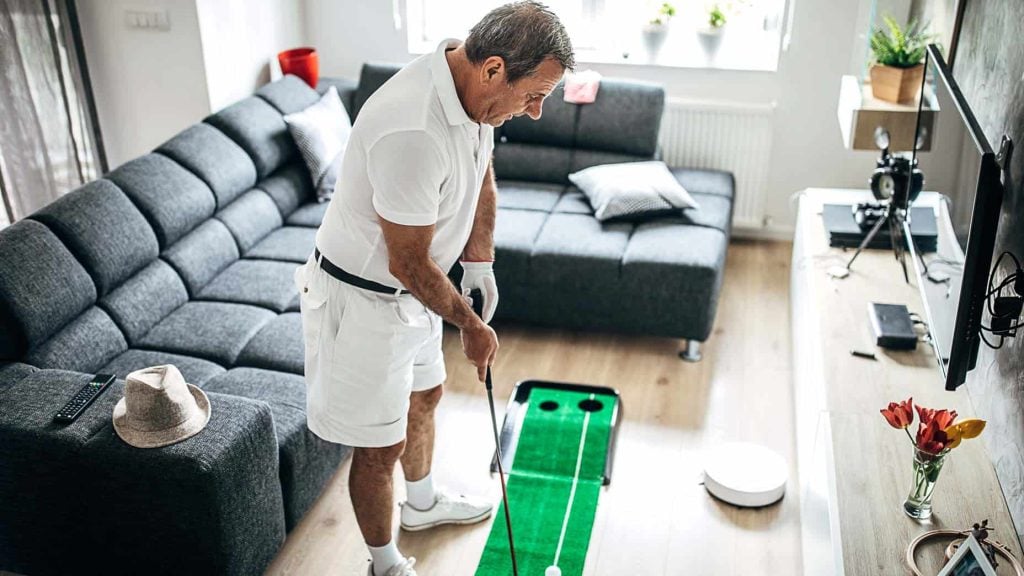
Try these 4 steps to get started:
- Pick Your Target: Get a small object or marker to aim at during practice. It can be a coin, tee, or spot on the putting green.
- Put the Target Where You Want It: Place it at different distances from your starting point. Start with shorter ones, then advance.
- Utilize Putting Aids: Use alignment sticks or laser devices to get feedback on alignment and swing path. This will help you stay on track.
- Analyze Your Results: Observe how your putts interact with the target. Look at patterns and adjust as needed.
By using targets and putting aids for feedback, you’ll be able to refine your alignment, swing path, and stroke consistency over time. Have fun experimenting and see your score drop!
Recommendations for Different Putting Arcs Based on Putting Style
To up your putting skills, it’s important to think about different putting arcs based on your putting style. To help, here is a table with columns such as “Putting Style”, “Recommended Putting Arc”, and “Advantages”. This will help you understand the best putting arc for you and how it can help your stroke consistency and alignment.
| Putting Style | Recommended Putting Arc | Advantages |
|---|---|---|
| Straight-back and straight-through | Straight-back and straight-through | Consistent tempo, square clubface at impact |
| Arcing stroke | Arcing stroke | Rhythm control, speed control |
For more info on this topic, consider unique details related to different putting styles. Recommendations for different putter types, like straight-back and straight-through or arcing strokes, can be explored too. Suggestions for grip, posture, and clubhead path that align with each putting style should also be included.
To improve putting performance based on different putting arcs, golfers using a straight-back and straight-through style should focus on maintaining a consistent tempo and keeping the clubface square at impact. Golfers with an arcing stroke should practice rhythm and controlling the speed of their backswing and follow-through.
By using these recommendations in practice sessions, golfers can learn about their own putting arc and work on alignment, swing path, and stroke consistency. This will help them improve their overall performance on the greens.
Chipping Practice: Developing Strike, Accuracy, and Distance Control
Develop your chipping skills in the comfort of your own home with the focus on strike, accuracy, and distance control. Discover how utilizing a small carpeted room and incorporating chipping drills can enhance your performance. With these techniques, you can refine your technique and fine-tune your game without the need for a golf course. Get ready to elevate your chipping game and improve your overall golf skills.
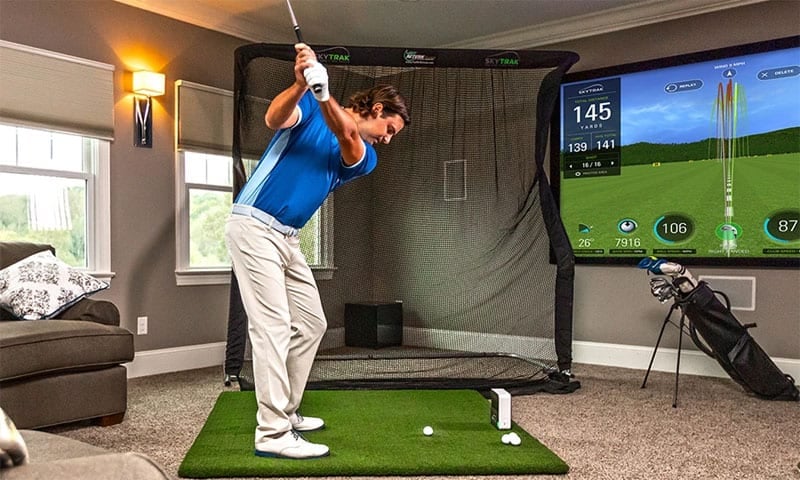
Utilizing a Small Carpeted Room and Chipping Drills
Golfers can benefit greatly from utilizing a small, carpeted room and incorporating chipping drills. They can create an ideal setup for practice within the room’s confines. This will help them focus on things like strike, accuracy, and distance control. Different chipping drills can be done in this space to enhance technique and improve performance.
Carpeted surfaces allow golfers to simulate real grass conditions. This means they can work on their short game without needing outdoor space. Chip shots like bump-and-run shots, pitch shots, and flop shots can be practiced with different clubs. This helps build versatility and adaptability in different scenarios.
Using feedback tools such as alignment aids or target markers can also help. These provide immediate feedback on stroke quality. This can help improve consistency and precision.
Golfers can make the most of a small carpeted room and purposeful chipping drills. This will help improve their strike ability, accuracy, and distance control – all necessary aspects of their short game.
Golf Swing Drills: Enhancing Technique, Impact Position, and Fundamentals
Enhance your golf swing technique, impact position, and fundamentals with these effective golf swing drills. Discover how using a mirror or window can provide valuable feedback, while varying speeds can help you elevate your game. Get ready to take your golf skills to new heights by incorporating these essential elements into your practice sessions.
Using a Mirror or Window for Feedback and Varying Speeds
Mirrors & windows provide helpful feedback for improving golf technique. As a reflective surface, golfers can observe their swings & make necessary adjustments. Adjusting practice speeds helps build control & precision.
Visual Feedback: Mirrors & windows are great for seeing swing mechanics in real-time. Identify any flaws & refine technique for better performance.
Swing Analysis: Analyze posture, alignment & club path using the reflective surface. Pinpoint areas to improve & make necessary changes.
Tempo Variation: Utilize mirrors & windows to change practice speed. Simulate different game scenarios & become comfortable with fast & slow shots.
Consistency Improvement: Muscle memory & consistency develop with regular practice. Establish reliable patterns that can be replicated.
Immediate Corrections: Immediate feedback helps identify errors & make corrections quickly. Avoid habits that are hard to break.
Building Confidence: Seeing swing mechanics improve builds confidence. Instills accomplishment & boosts self-assurance on the course.
Mirrors & windows are invaluable tools for honing golf skills. Visual feedback allows for analysis & adjustment. Practicing at different speeds aids in control & consistency. Incorporating these techniques into practice routines leads to improved performance.
Optional Extras: Golf Fitness Exercises and Golf Psychology
Discover the optional extras that can enhance your golf practice at home. From incorporating yoga, stretching, and core strength exercises to utilizing mental practice techniques and visualization, these additions can take your game to the next level. With the right fitness exercises and a focus on golf psychology, you can improve your physical abilities and mental resilience on the golf course. So, let’s explore these optional extras and unlock your full golfing potential.
Incorporating Yoga, Stretching, and Core Strength Exercises
Incorporating yoga, stretching, and core strength exercises is a must for home golf practice! Not only do they help with physical fitness, but they also boost overall golf course performance.
- Yoga: Practicing yoga aids in flexibility, balance, and stability – all vital for golf swings.
- Stretching: Regular stretching keeps range of motion optimal and prevents injuries. It also increases muscle activation during the swing.
- Core Strength Exercises: Strengthening the core muscles is key to power and stability in the golf swing. Exercises targeting the abs, lower back, and hips increases control and coordination.
- Improved Swing Mechanics: Incorporating these exercises into regular training boosts swing mechanics by promoting proper body alignment, rotation, and weight transfer.
- Enhanced Endurance: Building endurance through activities like yoga curbs fatigue during long rounds of golf and allows better focus.
Incorporating yoga, stretching, and core strength exercises into your at-home routine can boost physical fitness, improve swing mechanics, and increase endurance, ultimately enhancing your golf course performance! Focus on physical conditioning and golf skill development to make huge improvements in your game.
Utilizing Mental Practice Techniques and Visualization
Mental practice and visualization are great for improving golf skills. The mind’s power can help with focus, concentration, and performance. Studies show mental practice works just as well as physical practice.
Visualization helps with muscle memory and confidence. Mentally rehearsing each swing can improve technique, timing, and shot selection. Create a mental image of success to improve course performance.
Positive self-talk and affirmations help manage stress and maintain focus. Replace negative thoughts with positive ones to boost confidence and belief in abilities.
A pre-shot routine with mental preparation is key. Deep breathing and visualizing shots can relax the body and mind. Reciting a mantra reinforces positive thoughts. A consistent pre-shot routine builds focus, calmness, and readiness.
Goal setting is important too. Set short- and long-term goals for driving distance, putting accuracy, etc. This helps stay motivated and track improvement.
Sports psychologists and mental performance coaches provide guidance on incorporating mental practice into training sessions. This enhances technical skills and cultivates a strong mental game.
Mental practice and visualization are essential for improving golf. Techniques such as visualization, positive self-talk, pre-shot routines, and goal setting can enhance the mental game. This leads to better performance on the course.
Summarizing Practice Methods and Additional Resources for Improvement
Practicing golf at home is a great way to sharpen skills and perform better on the green. Utilize different training methods and resources such as chipping, putting, and driving to raise your game. Spend time on each area individually, concentrating on technique and performance.
Utilize training aids and equipment for a better practice session. Invest in items like swing trainers, simulators, and putting mats. The tools offer feedback and help refine skills. Use video analysis as well. Record your swing and assess it. Identify what needs correction and make the necessary adjustments.
Work on the mental game too. Visualize and practice focusing tactics to better concentration, self-confidence, and performance. Stay informed and up-to-date on the latest golf resources and material. Use online tutorials, books, and training programs for tips on improvement.
If you need personalized instruction and feedback, look for guidance from golf professionals or coaches. They can identify areas of improvement tailored to your game and provide special practice methods.
Create a practice routine that’s consistent and tailored to your goals. A regular practice schedule will maximize improvement and lead to steady progress. Remember, practice is key to becoming a better golfer. Incorporating these methods and resources to your routine will make a difference.
Budget-Friendly Options: Practicing Golf at Home on Various Budgets
Practicing golf at home doesn’t have to break the bank! Discover budget-friendly options for improving your swing and perfecting your short game. From basic setups to premium equipment, we’ll explore various options that cater to different budgets. Get ready to take your golf skills to the next level without leaving the comfort of your home. Let’s dive into the world of budget-friendly golf practice options!
Long Game Setup Options: Basic, Intermediate, and Premium
For those aiming to build a practice zone for long-game improvement at home, 3 options exist – basic, intermediate, and premium. These setups suit different budgets and provide varying features and equipment to upgrade your practice.
Let’s make a table to understand the components of each setup better:
| Basic Setup | Intermediate Setup | Premium Setup | |
|---|---|---|---|
| Hitting Mat | Hitting Mat | High-quality Turf Hitting Mat | |
| Netting | Netting | Enclosed Hitting Bay with Professional-Grade Netting | |
| Launch Monitor | Not Included | Entry-Level Launch Monitor | Advanced Launch Monitor with Detailed Data Analysis |
| Club Holder | Basic Club Holder | Golf Bag Stand with Multiple Organizer Compartments | Customized Golf Bag Stand with Integrated Technology Features |
These setups offer various choices based on your demands and tastes. The basic setup provides main elements such as a hitting mat and netting to guarantee safety and accuracy during practice. It is good for starters or those on a strict budget.
The intermediate setup goes up a step by including high-grade turf in addition to the needed hitting mat and netting. It gives a more lifelike feel when practicing long shots. It also involves an entry-level launch monitor that gives fundamental feedback on swing data.
For golf lovers wanting the top-notch home practice experience, the premium setup offers the best equipment and features. Utilizing an enclosed hitting bay with professional-grade netting, one can safely practice strong shots without worrying about damage.
The advanced launch monitor provides detailed data analysis, letting you monitor progress and make informed changes to your swing. Furthermore, the customized golf bag stand not just arranges your clubs, but also integrates technology features for added ease.
No matter which option you pick, having a designated area for practicing your long game at home can considerably upgrade your proficiency. By using these setups consistently and taking advantage of the included features, you can refine your technique, swing stability, and overall performance on the golf course.
If you’re ballin’ on a budget or living the golfing luxe life, these short game setup options have you taken care of.
Short Game Setup Options: Basic, Intermediate, and Premium
Want to set up your short game practice area at home? You have three options: basic, intermediate, and premium. They cater to golfers of various skill levels and budgets.
Basic setup includes a hitting mat, targets/flags, and practice balls. It’s an easy, budget-friendly way to practice your short game.
Intermediate setup involves investing in a portable putting green with multiple holes. This lets you simulate different putting scenarios and get better at alignment, stroke consistency, and distance control. You can also add chipping aids like practice nets or specialized targets.
Premium setup has state-of-the-art equipment and technology. Examples include an indoor putting system with adjustable slopes and speed controls, virtual reality simulators for course play, and swing data analysis devices. These high-end options take your practice to another level.
Choose based on your budget and skill level. Regular practice with different setups can help you develop consistency, accuracy, and confidence in your short game skills. Quality is key!
The Importance of Quality Hitting Mats and Nets for Safety and Accuracy
Hitting mats and nets are essential for safe and accurate golf practice at home. It’s key that they are of high quality, as they give a stable, cushioned surface. This stability reduces risk of injury from repetitive impact on tough surfaces. Nets also play an important role, containing golf balls and stopping them from causing harm or damage. By investing in high-quality mats and nets, golfers can practice with assurance and focus on getting better without worrying about accidents.
When deciding on mats and nets, it’s crucial to think about their durability and construction. Quality mats are specifically designed to handle regular use, so they keep their shape and softness. This means golfers don’t need to replace them often. Nets made of durable materials like nylon or polyester can take the impact of golf balls and contain them. By getting mats and nets that can last, golfers make a long-term investment that improves practice.
Size and design of mats and nets are important too. Mats with a lot of surface area let golfers set up and practice comfortably. Nets with a big width and height give a larger target area, helping golfers aim accurately. The right mats and nets let golfers imitate real course conditions and improve their skills.
To ensure safety and accuracy during practice, it is best to put mats and nets in an open, well-ventilated area away from breakable items. That way, even if a shot goes off course, there’s little risk of damage or injury.
Virtual Practice: Exploring the World of Golf Simulators
Explore the world of golf simulators with the PhiGolf WGT Edition Simulator and its exciting features. Step into the virtual realm of golf practice that allows you to improve your skills and enjoy the game right from the comfort of your home. Discover how this innovative simulator brings the golf course to your living room, providing an immersive and realistic experience. Get ready to enhance your swing, refine your technique, and take your golf game to new heights.
The PhiGolf WGT Edition Simulator and Its Features
The PhiGolf WGT Edition Simulator is an advanced golfing system that offers amazing features. It has realistic graphics and immersive gameplay for at-home golfing.
- Realistic Gameplay: Choose from virtual courses and compete with other players worldwide.
- Wireless Swing Analyzer: Tracks and analyzes club speed, tempo, and swing path.
- Multiple Game Modes: Go for a full round of golf, skill challenges, or practice specific shots.
- Compatibility with Smart Devices: Control the simulator with your preferred device.
Plus, it lets you join online tournaments and track your progress. With a user-friendly interface and versatile functionality, it’s perfect for golfers who want to practice from home.
PhiNetworks Co., Ltd. developed this simulator. With years of research, they combined cutting-edge tech and passion for the sport. It’s popular worldwide for its graphics, realistic gameplay, and accurate swing analysis.
Whether you’re aiming for the green or a lamp, this guide has you covered for practicing golf at home.
A Comprehensive Guide to Home Practice: Putting, Full Shots, and Wedge Play
Enhance your golf skills from the comfort of your home with this comprehensive guide. Discover effective techniques and tools for putting to improve stroke quality and engage in fun games. Master full shots by focusing on impact tendencies, swing tempo, and precise low point control. Take your wedge play to the next level as you work on distance control, creating the perfect trajectory, and mastering turf interaction. Elevate your game and see the results on the course.
Putting Practice: Stroke Quality, Tools, and Games
Putting is a key part of golf that needs focus, accuracy, and consistency. This section looks at bettering stroke quality with the help of tools and activities. It provides tips on alignment, swing path, and stroke consistency for putting practice.
- Target & Putting Aids for Feedback: Putting aids and a target can give feedback on alignment, swing path, and stroke consistency, so adjustments can be made to get better putting technique.
- Different Putting Arcs Based on Style: Different golfers have different styles. This section looks at arcs for individual styles, to help them enhance stroke quality and improve results.
- Small Carpeted Room & Chipping Drills: This section focuses on chipping practice, with an emphasis on strike, accuracy, and distance control. A small carpeted room is good for chipping drills that can be done at home.
This section also looks at using mirrors or windows to see visual feedback on swing drills, with varying speeds. It looks at extras such as yoga, stretching, core strength exercises, mental practice like visualization, for better performance.
Additionally, budget-friendly options for practicing golf at home are explored. It discusses setup options for long and short game practice, from basic to intermediate and premium choices.
Lastly, it stresses the need for quality mats and nets for safety and accuracy during home practice. It looks at golf simulators offering virtual practice, highlighting the PhiGolf WGT Edition Simulator for its realistic golfing experience.
Mastering the swing tempo can make your neighbors appreciate metal drummers even more!
Full Shot Practice: Impact Tendencies, Swing Tempo, and Low Point Control
Full shot practice is vital for bettering golf technique and attaining consistency in ball striking. To improve, analyze impact tendencies, master swing tempo, and upgrade low point control.
First, assess clubface angle, clubhead speed, and ball position at impact. Pinpoint inconsistencies or deviations from desired conditions to optimize results.
Next, cultivate a consistent and balanced rhythm in swings. Practice drills that include accelerating the swing, transitioning fast, and keeping a smooth tempo help.
Also, refine low point control for accurate contact with the ball. Focus on body rotation, weight transfer, and a shallow angle of attack.
Finally, explore additional resources and techniques that suit your needs and goals. Research proves that practicing full shots regularly at home leads to improvements in distance control, accuracy, and ball striking. Therefore, practice impact tendencies, swing tempo, and low point control.
Wedge Play: Distance Control, Trajectory, and Turf Interaction
Distance Control – Golfers must hone their ability to precisely control the distance of their wedge shots. This is achieved through practice and tweaking one’s swing mechanics. Mastering the right speed and length for each shot guarantees optimal distance control.
Trajectory Tweaking – Wedge play also involves changing the trajectory of the ball to fit different shot types. Skilled golfers can make high-trajectory shots that land softly on the green or low-trajectory shots that roll after landing. Understanding how to adjust swing mechanics and clubface angles allows for this versatility.
Turf Interaction – How the club interacts with the turf during wedge play affects the outcome of the shot. Knowing how various lies and grass types influence ball contact is essential for consistent performance. Striking down on the ball while keeping divot patterns appropriate maximizes distance control and accuracy.
Course Management – Wedge play means making strategic choices regarding which shots to hit from specific distances or lie conditions. This involves evaluating factors like wind direction, hazards, pin positions, and green contours.
Practice Drills – To improve wedge play skills, golfers should add focused practice drills into their training. This could be target-oriented distance control exercises, experimenting with trajectories, and practicing shots from different lies and turf.
Professional Coaching – Golfers can also benefit from seeking help from a professional coach who can offer personalized instruction and feedback on wedge play techniques. The combination of knowledge and regular practice enables golfers to refine their skills and increase their performance in this key part of the game.
Conclusion
Golfers can develop their skills in the comfort of their own homes. Reference data on how to practice at home can help individuals explore different techniques and drills. A practice net, putting, or chipping can be set up in the living space.
Training aids and tools, such as putting mats, swing trainers, and alignment sticks, can assist with honing specific aspects of the game. This can help players understand their strengths and weaknesses, and experiment with new techniques.
Mental practice is also important. Visualizing shots, watching videos, and reading golf-related literature can all contribute to a golfer’s engagement with the sport. This helps them develop strategies and refine their game.
Home practice has been a common method of improving one’s game for decades. Golfers can experiment with new strategies and approaches when they can’t be on an actual course. Home practice offers convenience and flexibility to enjoy the game.
Some Facts About How To Practice Golf At Home:
- ✅ Practicing golf off the course is just as important as playing on the course. (Source: golfspan.com)
- ✅ In order to practice golf at home, focus can be given to putting, chipping, and golf swing drills. (Source: golfinsideruk.com)
- ✅ It is possible to practice golf at home during the winter months or when it’s difficult to get to the golf course. (Source: golfbox.com.au)
- ✅ Fitness exercises, mental practice, and watching golf on TV can all contribute to practicing golf at home. (Source: sundaygolf.com)
- ✅ Using training aids, launch monitors, and mirrors can provide valuable feedback and improve practice sessions at home. (Source: hackmotion.com)
FAQs about How To Practice Golf At Home
How can I practice golf at home during the COVID pandemic?
Practicing golf at home has become more popular due to the Covid pandemic and the need for indoor activities. You can practice putting at home using items like your putter, golf balls, a putting mat or green, and putting training aids like a “putting mirror” and “gates”. Additionally, you can work on your swing at home by using your clubs, a mirror to check your swing positions, and various swing drills that don’t require a mat or net. Chipping can also be practiced at home using a wedge, golf balls, a golf mat, and chipping drills. Mental practice, such as visualizing and reviewing your course management, can be done at home as well.
What are some at-home putting drills I can try?
There are several at-home putting drills you can try to improve your stroke consistency and speed control. These include the book drill, the quarter drill, the yardstick drill, and the PuttOut Putting Trainer. In the book drill, you place a book behind the hole and practice putting to stop the ball within the width of the book. The quarter drill involves placing a quarter just outside the toe of your putter and putting while trying to keep the putter inside the quarter. The yardstick drill uses a yardstick to practice making a stroke that takes the ball the appropriate distance. The PuttOut Putting Trainer is a training aid that helps with practicing your putting stroke and simulates putting to a smaller target.
What are some golf swing drills I can do at home?
There are several golf swing drills you can do at home to improve your technique, impact position, and fundamentals. Some at-home swing drills include using a mirror or window for feedback, practicing at different speeds to transfer swing changes onto the golf course, swinging with feet together to improve balance, swinging on one leg to improve precision, and using a towel under the arms to improve arm connection. Other drills involve practicing with a smaller club to focus on clubface at impact, using a chair to practice turning behind and around, and pausing at the top of the swing to focus on transition. These drills can help you improve various aspects of your golf swing.
How can I practice golf fitness at home?
Focusing on golf fitness at home can benefit your golf game. Some recommended golf fitness exercises include yoga, stretching, and core strength exercises. These exercises help improve flexibility, balance, and overall fitness, which can contribute to better performance on the golf course. You can also consider following a TPI workout program specifically designed for golfers. By incorporating golf fitness into your at-home practice routine, you can enhance your physical abilities and potentially improve your swing and overall game.
What are some tips for practicing golf at home with limited space?
If you have limited space at home, there are still ways to practice golf. For putting practice, you can use carpeted floors and set up a small target. Chipping drills can be done in a small carpeted room using a wedge and soft practice balls. When practicing your swing, you can focus on mirror drills to analyze your positions, improve balance, and work on your grip. It’s also beneficial to practice at different tempos and speeds to transfer changes onto the golf course. Even with little room, you can still work on various aspects of your game and make practice impactful.
Do I need expensive equipment to practice golf at home?
No, expensive gadgets are not necessary for effective practice at home. While certain training aids and feedback tools can enhance your practice, there are many affordable options available. For example, you can use a carpeted area for putting practice, improvise a hitting net with household items, or use a mirror for swing feedback. The goal is to create an inviting practice area that is easily accessible and utilizes the space and resources you have available. With creativity and resourcefulness, you can practice golf effectively at home without breaking the bank.
